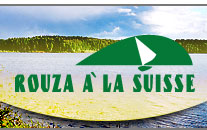| Ruza territory
Ruza District is located in the western part of the Moscow Region. It extends for 66 kilometers north-south and 50 kilometers east-west. The total area of the district is 1,559 square kilometers. The district center, the town of Ruza, is situated on the Ruza River, a large tributary of the Moscow River. In terms of distance from Moscow, the district holds an intermediate position between the so-called Close and the Remote zones of the Moscow Region. Its present population is 68.8 thousand, including 40.2 thousand of urban population and 28.6 thousand of rural one.
The main asset of Ruza District is its unpolluted environment. Without exaggeration, it can be called the best resort zone in the Moscow Region. The district features numerous holiday centers, health resorts, specialized creative work centers for artists and writers. The most notable one among them is Maleevka Creative Work Center for Writers, which saw K. Paustovsky, A. Fadeev, A. Gaidar, M. Svetlov, A. Tolstoy. The center was founded in 1927. There is also Ruza Creative Work Center for composers established in the 1930s, once a place of work and recreation of T. Khrennikov, B. Mokrousov, I. Dunaevsky, A. Novikov, A. Khachaturyan, S. Tulikov, K. Listov, Y. Frenkel, A. Pakhmutova, and L. Lyadov.
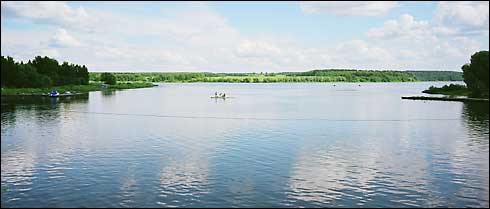
Another well-known center of that kind, VTO Ruza Creative Work Center for theater workers was established on a bank of the Moscow River not far from Staraya Ruza in 1961. It used to accommodate such prominent persons as N.A. Obukhova, E.D. Turchaninova, S.V. Giatsintova, A.A. Popov, M.I. Zharov, L.O. Utesov. The famous writer and legendary expert on pre-Soviet Russia Vladimir Alexeevich Gilyarovsky used to spend summers in his dacha in Kartino village located not far from Tuchkovo. His dacha burned by fascist invaders during World War II was reconstructed in 1958-1964 and presently houses his memorial library.
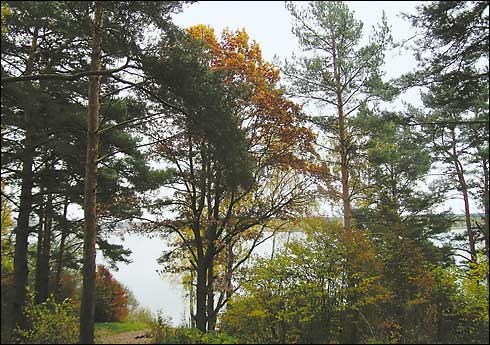
| Forest thick on the shores of Ozerninskoye Water Reservoir |
The most notable spas among the district's health resorts are the health center near Dorokhovo that uses local balneal resources (potassium and magnesium sulphate waters) and specializes in digestive ailment treatment, and A.M. Likhodei Medical Rehabilitation Center (Rus' Health Complex). Picturesque local riverbanks and water reservoir shores abundant in fishing bases and boat stations in the vicinity of the town of Ruza.
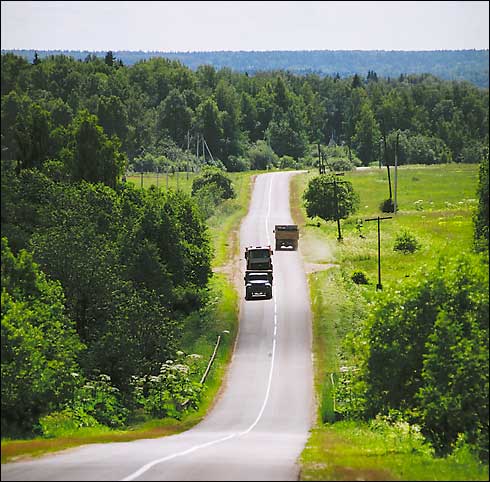
Ruza District features a considerable number of Russian nobility's hereditary estates of late 18th-19th centuries in different states of preservation. Their list includes Arkhangelskoye, Annino, Bogorodskoye, Vasilievskoye, Volynshchina-Poluektovo, Nikolskoye-Gagarino and Borodenky, Pokrovskoye-Sheremetyevo, and Porechie.
The town of Ruza
The ancient town of Ruza! A stronghold of the Moscow Power, its sentinel, this outpost on the border dividing the Principalities of Muscovy and Smolensk got its name from the homonymous river. Its walls have seen Mongolian, Lithuanian, French and German-fascist invaders.
Its time of origin is unknown. The earliest record mentioning the town is Ivan Kalita's testament dated 1328. According to a legend, Ruza was the birthplace of Ivan Kalita. The town fortress sat on a riverbank that was a strategically important western border of the Principality of Muscovy. The Ruza coat of arms bears four crossed swords "as a token of many battles that happened in the locality in ancient times".
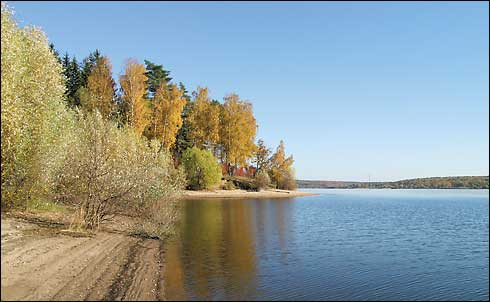
| Sandy bank of Ozerninskoye Water Reservoir |
The very name of the town probably originates from the Mongolian word "ruza" meaning "castle", bringing back to memory the battles with Mongolian hordes in that area in 1382. According to another theory, the name Ruza arises from the Baltic "ruosa" - "a narrow meadow along a brook". After the death of Dmitry Donskoi, the town of Ruza came into possession of his son Grand Duke Yury Zvenigorodsky. In 1433, Ruza passed to Dmitry Yurievich (Shemyaka), and this is where he prepared his unsuccessful seizure of Moscow. In 1453, Ruza found itself in possession of Grand Duke of Muscovy Vasily Temny, who gave it as an appanage to his son Boris Vasilievich Volotsky together with the town of Volokolamsk. In 1503, Ruza got back into the ownership of the older branch of Grand Dukes of Muscovy. In the 1514 war against the Lithuanian troops, Ruza militiamen conquered Smolensk. Upon the conquest of Kazan by Mongolians, Ivan the Terrible presented Ruza to Mongolian prince Simeon who owned it until his death in 1565. The last attack on the fortress of Ruza took place in 1618 by the troops of Polish prince Vladislav. Unable to conquer the town, the interventionists wiped out small settlements around the town (Ivanovskoye, Shiklovskoye, Zaretskoye, Boklashinskoye, Orekhovskoye, Kizilovskoye, Spasa na Kochkakh, Demino). There is a popular belief that the retreating Polish hordes buried looted treasures in dense forests of Ruza district. Before that invasion, Ruza had 22 churches and Georgievsky cloister; after it, there were only 4 churches left. On the 28th of August 1619, Tsar Mikhail Fedorovich in his charter exempted Ruza residents from all tributes for 4 years.
Since then, the fortress of Ruza has lost its importance for good and has not been reconstructed ever since. In the second half of the 16th century, Ruza started to host local fairs twice a week. In the 18th century, the offices of authorities and government institutions were transferred to posad (the trading quarter). But up to the early 19th century, Ruza used to look more like a village than a town.
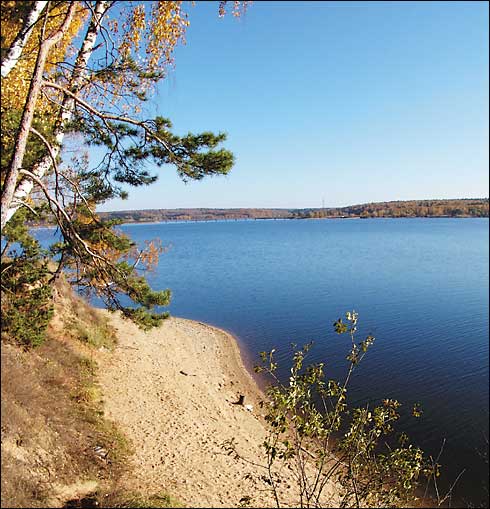
In 1812, 20,000-strong French corps of Beauharnais entered Ruza lands without a fight and started to advance toward Moscow, looting and marauding. Near the settlement of Oreshek, their way was blocked by 2,000 cavalrymen and 500 infantrymen commanded by Winzingerode.
10-times stronger enemy was offered a stubborn 6-hour long battle, after which the Russian troops retreated into the woods and kept attacking the enemy in the north of the Ruza district until Napoleon's flight from Moscow. As a tribute to the courage and dedication of Russian troops, two monuments were erected in the district - in the village of Shelkovka housing M.I. Kutusov's headquarters after the battle of Borodino and in the village of Krymskoye. The battlefield between the rearguards of the Russian army, commanded by general M. Miloradovich, and the advance-guard of the French army, commanded by marshal Murat, took place on the 10th of September 1812. This battle slowed down the enemy and permitted the Russian army to withdraw its main forces back to Moscow.
By the end of the 19th century, the town of Ruza had three industrial enterprises - two tanneries and one malt factory. The uyezd (district in pre-Soviet Russia) featured five brickworks, two distilleries, one cloth factory and three spinneries. Agriculture started to develop in the 1830s.
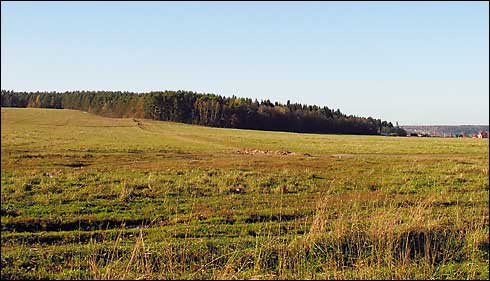
Prior to 1917, Ruza uyezd was divided into 10 volosts: Ashcherinskaya, Vasilievskaya, Gorbovskaya, Klementyevskaya, Momoshinskaya, Morevskaya, Nikolskaya, Oreshkovskaya, Sudnikovskaya, and Khotebtsovskaya. 60% of the uyezd was forest. Plough-lands and water-meadows took about 20 %. The principal crops included rye, oats, potatoes, and flax. The grain-crop yields were low. The population was engaged predominantly in timber cutting and wickerwork industries. In winter of 1941-42, at the height of World War II, Ruza district became a site of fierce battles as Hitler troops strived to approach Moscow. On the 26th of October 1941, the town of Ruza was occupied by fascists. The task to liberate the area fell to the cavalry corps commanded by general L.M. Dovator, reinforced by two tank subdivisions. Ruza was liberated on the 17th of January 1942.
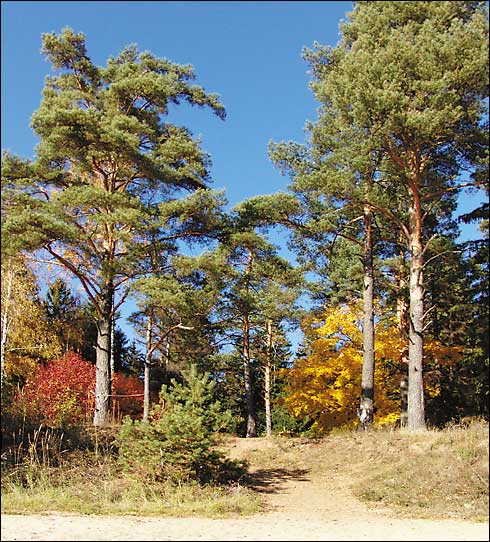
In ancient settlement of Ruza, there was an earthen citadel, the so-called "town". It formed a good natural stronghold, being located on a high hill and encircled by the Ruza, Gorodenka and Artyushka (Sorochka) rivers on three sides and by a ditch on the fourth one. Along the hill ridge runs a powerful earth mound up to 30 meters high, which spans one and a half kilometers in circumference. In 1618, a timbered area with six towers was built on the mounds, strengthened by a fresh portion of earth, which helped Ruza residents to successfully resist attacks of Polish troops. The "town" burned down in the following year, 1619, and has never been reconstructed. Its gradually collapsing towers lasted until the end of the 17th century. In the late 18th century, Ruza became the administrative center of the uyezd. This incited the replacement of wooden public buildings, first and foremost churches, by stone ones.
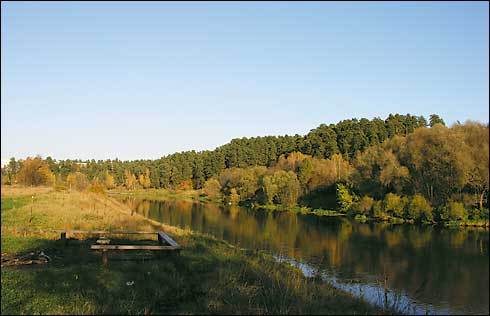
| Vasilievskoe village. Moscow River. A. Gertsen's estate |
The most notable ones among its architectural monuments are Dmitrovskaya Church, built from brick with some white stone ornaments in 1792. Intricate space arrangement and decoration techniques can be traced back to the baroque architecture. Unfortunately, later additions have concealed this outstanding piece of architecture, doubtlessly created by a talented master.
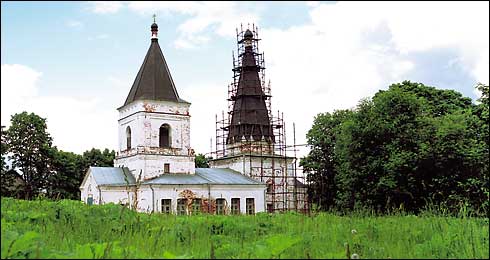
| The oldest church in the Moscow region - the Church of the
Holy Mother Icon "The Sign" near the estate Annino. The foundation and walls -
14th century, the top - 16th century. |
Voskresensky Cathedral located on Partizan Square was built from 1714 to 1721. Significant portions of the buildings have been lost quite recently. Borisoglebskaya Church erected in 1801 and Pokrovskaya Church constructed in 1781 in the transitional style between the baroque and the classical architecture have also survived until present days.
One of the first ethnographical museums in the Moscow Region was established in Ruza in 1905. Ruza is the birthplace of the artist S. Ivanov, a member of The Itinerants Society.
Хозяйственная история района
Encyclopaedia, vol. XXVII-а, St-Petersburg, Delo Publishing House, form. Brockhaus and Efron, 1899
Ruza is an area in Moscow Province; a left tributary of the Moscow river. The river originates in Volokolamsk uyezd, at the border with Smolensk province. Direction southeast, length 138 verst (1 verst = 3500 ft.), width up to 25 sazhen (1 sazhen = 2m 13 cm), shallow, a lot of fords. The banks are stony and in some places picturesque. On them sits the town of Ruza and up to 80 settlements. Timber rafting section is 99 verst.
Ruza is the administrative center of an uyezd in Moscow Province, at the Ruza river. Foundation date is unknown. In 1328, Grand Duke of the Principality of Muscovy Ivan Kalita gave it as an appanage to his son Ivan. In the Troubled Times, Ruza was fortified, remnants of the mounds have survived until present time. Population - 2,505 (1,183 males. and 1,322 females). 4 churches. 2 municipal and 2 parochial schools. 2 alms-houses; the uyezd hospital. Municipal income 10,209 rubles, expenditures 10,036 rubles, incl. those on municipal government 2,299 rubles, on educational institutions 1,588 rubles, on medical purposes 490 rubles. Commerce is insignificant. One small tannery.
Ruza uyezd takes up 1989.3 sq verst or 207,210 dessiatinas (1 des. = 2 ? acres). The northern part of the uyezd features a watershed between the Lama river (flowing into the Shosha river, a tribute of the Volga) and the Ruza river (a tribute of the Moscow river). From the borders of Volokolamsk uyezd to the village of Kazanovo the watershed runs on an undulating and mostly open terrain, while from Kazanovo village to Teploye village and onward the area is wooded and cut by ravines. The remaining part of the uyezd constitutes a plain sloping down to the Moscow river interrupted by hills and ravines. The soil of the uyezd consists of heavy loam, and only along the Ruza river banks there is a narrow strip of sand; there are also patches of clay-silt and sand-clay soils.
Except for a small part in the north, Ruza uyezd is watered by tributes of the Moscow River, which dissects the whole southern part of it. The Moscow River is navigable, however, there are no stations on it within the uyezd limits. Of great importance to the uyezd is the Ruza river (a tribute of the Moscow River) due to considerable timber rafting. Among other rivers the significant ones are the Iskonya (a tribute of the Moscow), the Ozerna (a tribute of the Ruza), and Mladshaya Istra (a tribute of the Bolshaya Istra). On the whole, the uyezd is poor in flowing water, the majority of the population uses water from wells and ponds. Lakes are few. The largest one - Anufrievskoye or Trostenskoye - is located in the eastern part of the uyezd (3.03 verst long and 2 verst wide) and is the source of the Ozernaya river. At lake Glubokoye (about 1 verst long and less than 0.5 verst wide) professor N.Y. Zagraf established a station for scientific research of the life of fish; the maximal depth of the lake is 44 archines (1 archine = 2 ft. 4 in.) Swamps are few; they are located along the Malaya Istra river near Anufrievskoye and Glubokoye lakes and in the valleys of other rivers. 67,557 dess. area is under forest cover. The forest is predominantly the pine one. In 1887, 939 dess. of land were in the possession of the government, 534 of the principality, 2,672 of the cloister and churches, 4,787 of the municipal and other authorities, 16,280 of peasants, 58,867 of the nobility, 14,160 of merchants and petty bourgeoisie, 6,889 of other owners; allotments to peasants made 102,086 dess. The nobility possessed 95 % of the privately owned land in 1865 and 61 % in 1895. According to 1892 research, of each 100 dess. of suitable land the plough-land accounted for 27.4 dess.; 4.1 dess. were in control of private landowners, 46.2 dess. of peasants. Of the peasants' lands 15,423 dess. were under rye, 9,415 under oats, 2,326 under barley, 1,457 under potatoes, 13 under buckwheat, 445 under pea, 1,317 under herbs, 835 under flax and 466 under hemp. In 1897 the harvest reaped from the lands in private ownership amounted to 5,540 chetverts (1 chetvert = 131.044 kg) of rye, 3,147 of oats, 124 of barley, 1,979 of potatoes; from the lands in control of peasants - 76,217 of rye, 36,936 of oats, 4,393 of barley, 48,294 of potatoes. Thanks to zemstvo (local council) assistance, fodder grass cultivation and other amelioration practices have been making their way in the uyezd in recent years. In 1897 the province zemstvo granted to peasants 3,212 rubles for purchase of agricultural tools, 2,461 of seeds and 285 of fertilizing pomace. The uyezd zemstvo spent 1,700 rubles on the same purposes. In spite of that, the population cannot live from farming alone. According to the zemstvo calculations, the amount needed for purchase of rye for inhabitants is 624,000 rubles, while the sum gained from sale of oats and potatoes is 145,000 rubles; thus the deficit amounts to 479,000 rubles or 1 ruble 4 kopecks per person. In 1894 there were 12,345 cattle-heads in the uyezd. There were 1,711 cattleless and 2,406 horseless homesteads. The population (exclusive that of the town) was 54,598 (21,408 m. and 33,190 fem.). Large prevalence of females is the result of an intense migration of males for winter period (the census took place on the 28th of January 1897). The most common local businesses are tanning, joinery & turnery, papermaking, wickerwork, etc. Persons engaged in non-farming businesses constitute 30% of adult population; more than two thirds of them migrate in search of seasonal work. To encourage basketry, zemstvo established a storehouse for the goods in the town of Ruza. In 1897 there were 24 plants and factories producing goods worth 90,500 rubles and employing 402 workers - 16 paper mills and weaving-mills (32,000 rubles with 113 workers), 1 crow-quill factory (20,000 rubles), 2 string-producing factories (55,000 rubles), 1 turnery (2,000 rubles), 1 paper-bag and box factory, 1 quarry, and 2 peat-cutting facilities. In 1894, there were 190 retail sales sites and 50 workshops. In the school year 1895-1896 there were 49 schools (including 32 zemstvo-managed ones) and 2,707 schoolchildren in the uyezd. There were 30 schools with libraries (all of them zemstvo-managed ones), public lections were organized in 27 schools. There is the uyezd hospital in the town of Ruza, the province hospital in the village of Petrovskoye, 2 out-patient stations. In 1897 the uyezd zemstvo received and spent 57,981 rubles, including 7,585 on the uprava (local authority) expenditures, 13,163 rubles on school education and 23,180 on medical services. Three alms-houses were financed by private donations. There is a post office in Petrovskoye village.
|


